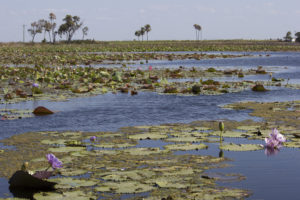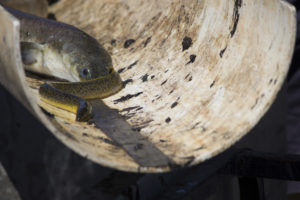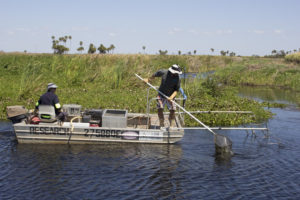Coastal wetland system restoration
Introduction
 Coastal wetlands occur adjacent to estuaries and coasts, and many are influenced by both tidal inundation and seasonal freshwater flooding. Depending on the amount of tidal influence they can range from fresh to very saline, and change their extents and salinities in response to seasonal floods. Coastal wetlands contain a diversity of plant communities from Melaleuca and water chestnut freshwater swamps to mangroves and salt marsh in more saline areas. These are transitional zones between terrestrial and freshwater habitats and estuaries and coasts, and they provide primary nursery habitats for fish such as barramundi, giant herring and tarpon. They are also vitally important to water birds, providing resting, nesting and feeding habitats for migratory birds, and acting as refuges for inland water birds during periods of droughts.
Coastal wetlands occur adjacent to estuaries and coasts, and many are influenced by both tidal inundation and seasonal freshwater flooding. Depending on the amount of tidal influence they can range from fresh to very saline, and change their extents and salinities in response to seasonal floods. Coastal wetlands contain a diversity of plant communities from Melaleuca and water chestnut freshwater swamps to mangroves and salt marsh in more saline areas. These are transitional zones between terrestrial and freshwater habitats and estuaries and coasts, and they provide primary nursery habitats for fish such as barramundi, giant herring and tarpon. They are also vitally important to water birds, providing resting, nesting and feeding habitats for migratory birds, and acting as refuges for inland water birds during periods of droughts.
Great Barrier Reef coastal wetlands
Coastal wetlands in the catchments of the Great Barrier Reef (GBR) provide extensive environmental, cultural and economic value. These wetlands play a role in protecting our coastline, buffering against wet season flood waters, improving water quality and maintaining fisheries productivity. While there is still approximately 87% of remnant wetlands left in the catchments of the GBR, only 30% of floodplain wetlands exist in some catchments. The remaining wetlands have been modified or impacted because of land use change (such as agricultural, aquaculture, peri-urban/urban, and industrial expansion).
Many of our wetlands no longer function properly and have lost their original value as habitat for native plants, fish, birds and other animals, have reduced capacity for carbon sequestration, and reduced flood storage capacity. They suffer from widespread alien weed and pest species infestations and degraded water quality. A large number have also lost their connectivity with estuaries that flow into the GBR lagoon. This in turn has impacted species that have a critical estuarine lifecycle phase and those species with commercial value that need to migrate between marine and freshwater habitats (e.g. barramundi), relying on this connectivity between the reef and shallow tidal and freshwater wetlands to reproduce and maintain their populations.
Solutions
 Recognising the role and value of wetlands as part of the broader Great Barrier Reef ecosystem, government agencies continue to invest funding through Natural Resource Management (NRM) organisations, community groups and landholders to repair and restore our wetlands. A number of wetlands projects have been undertaken or are underway to improve their overall function. These projects have focused on a range of threats including removing weeds (both aquatic and land species). More recently projects are reinstating natural water flows and connections to estuaries and installing fish passage structures to help fish move between wetlands and the broader marine environment. Feral animals control programs are now focusing more on wetland environments and increasingly constructing water treatment systems are being built to remove contaminants flowing from surrounding land.
Recognising the role and value of wetlands as part of the broader Great Barrier Reef ecosystem, government agencies continue to invest funding through Natural Resource Management (NRM) organisations, community groups and landholders to repair and restore our wetlands. A number of wetlands projects have been undertaken or are underway to improve their overall function. These projects have focused on a range of threats including removing weeds (both aquatic and land species). More recently projects are reinstating natural water flows and connections to estuaries and installing fish passage structures to help fish move between wetlands and the broader marine environment. Feral animals control programs are now focusing more on wetland environments and increasingly constructing water treatment systems are being built to remove contaminants flowing from surrounding land.
 While there have been many positive outcomes from these programs, continued success needs to be supported by scientific data to continually improve our understanding and techniques to enhance these wetlands’ interventions. TropWATER is providing research services to generate data to assist community and landholders to achieve long-term sustainable outcomes for coastal wetlands.
While there have been many positive outcomes from these programs, continued success needs to be supported by scientific data to continually improve our understanding and techniques to enhance these wetlands’ interventions. TropWATER is providing research services to generate data to assist community and landholders to achieve long-term sustainable outcomes for coastal wetlands.
Further Reading
Waltham, NJ, 2017, Aquatic fauna occupying Mungalla wetland complex following bund wall removal. Centre for Tropical Water and Aquatic Ecosystem Research (TropWATER) Publication 17/24, James Cook University, Cairns, 30 pp.
Waltham, N., Fixler, S., 2017. Aerial Herbicide Spray to Control Invasive Water Hyacinth (Eichhornia crassipes): Water Quality Concerns Fronting Fish Occupying a Tropical Floodplain Wetland. Tropical Conservation Science 10, 1-10.
Waltham, N., Schaffer, J., 2016. Baseline aquatic assessment of wetlands identified for feral pig fence exclusion, Archer River catchment. TropWATER James Cook University.
Waltham, N., Schaffer, J., 2017. Continuing aquatic assessment of wetlands with and without feral pig and cattle fence exclusion, Archer River catchment. TropWATER James Cook University, Townsville Australia, p. 44.
Waltham, NJ, Davis, A, (2017) Delivering biodiversity values for the Barratta Creek catchment. Centre for Tropical Water and Aquatic Ecosystem Research (TropWATER), Publication 17/06, James Cook University, Townsville, 56 pp.

